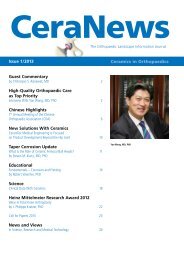BIOLOX - Nanocomposite for Arthoplasty
The Fourth Generation of Ceramics
The Fourth Generation of Ceramics
Create successful ePaper yourself
Turn your PDF publications into a flip-book with our unique Google optimized e-Paper software.
Tribology and Arthroplasty<br />
Competence in Ceramics<br />
Material Properties<br />
The Strengths of <strong>BIOLOX</strong> ® delta<br />
Intelligent Rein<strong>for</strong>cement Mechanisms<br />
8<br />
A Fundamental Difference<br />
Material sciences make a distinction between<br />
fracture strength and fracture<br />
toughness. Fracture strength is the maximum<br />
mechanical stress a material can<br />
withstand without fracturing. Fracture<br />
toughness is the resistance of a material<br />
to the propagation of cracks. Ceramic<br />
materials that have been in use <strong>for</strong> a<br />
number of years, such as <strong>BIOLOX</strong> ® <strong>for</strong>te,<br />
already have a very high fracture strength.<br />
<strong>BIOLOX</strong> ® delta additionally exhibits an<br />
extremely high fracture toughness. It has<br />
a much higher capacity than other ceramic<br />
materials to resist the onset of cracking<br />
and to arrest the propagation of cracks.<br />
This property is based on two strengthening<br />
mechanisms.<br />
Airbag Function<br />
The first strengthening mechanism is derived<br />
from the dispersion of tetragonal<br />
zirconium oxide nanoparticles in the microstructure.<br />
These particles, which are<br />
homogenously distributed throughout the<br />
stable aluminum oxide matrix, produce<br />
local pressure peaks in the area of cracks<br />
and thereby counteract their propagation.<br />
Counteracting Crack Formation<br />
The second strengthening mechanism is<br />
the result of in situ <strong>for</strong>mation of plateletshaped<br />
crystals in the oxide mixture. These<br />
platelets prevent cracking and crack propagation<br />
by deflecting the crack path and<br />
neutralizing crack energy. As a result of<br />
these strengthening mechanisms, <strong>BIOLOX</strong> ®<br />
delta allows implant designers to create<br />
component geometries that were not possible<br />
with previous ceramic materials.<br />
Crack propagation<br />
Crack propagation<br />
Aluminum<br />
oxide<br />
Platelet<br />
Zirconium<br />
oxide<br />
The principle of conversion rein<strong>for</strong>cement: zirconium<br />
oxide particles act like airbags by absorbing<br />
impacting <strong>for</strong>ces.<br />
The principle of platelet rein<strong>for</strong>cement: plateletshaped<br />
crystals block the propagation of cracks and<br />
thereby increase overall strength.












